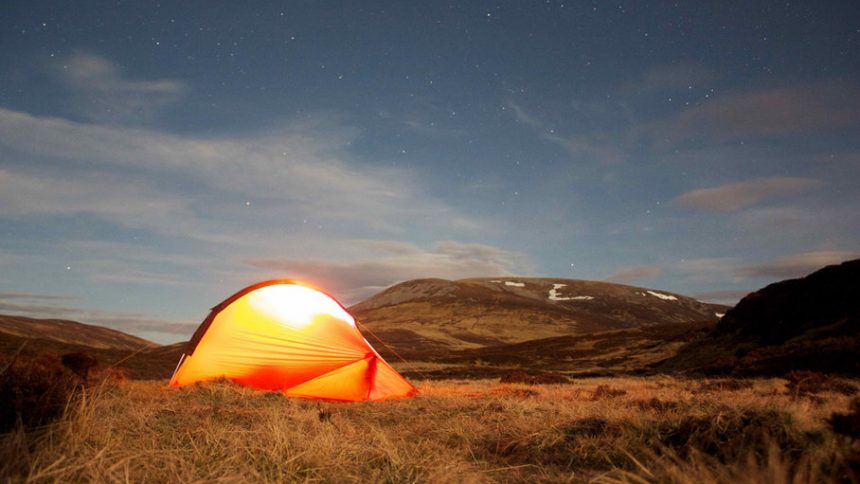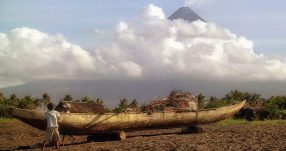The problem with traditional camp grounds is that they can be packed with other campers. If you’re keen to get away from it all – and you have the know-how – free camping can be a great alternative because it’s just you and the great outdoors. If you fancy doing a bit of DIY camping, here’s everything you need to know about wild camping including some cool wild camping tips and tricks, so that your upcoming free camping trip is an adventure not a disaster!
Photo By: Nick Bramhall
What is Wild Camping

Wild camping can be a few different things. It can either be going it completely solo, taking yourself off the beaten path in a forest, desert or beach and setting up your tent. It means there are no toilets or shower blocks in sight and you’re taking care of yourself. For some people, it means going to a huge camping ground where you’re a little bit isolated from everyone else, yet there are still amenities nearby so that you’re not ‘roughing it’ quite as much.
Either way you need to take care of the following points:
- Beware of whether you’re allowed to camp in this particular area? Is it public land? Private property? A national park? Remember wild camping can be illegal in many – but not all – areas.
- Be aware of any rules. Are you allowed to light a campfire? Are there specific areas where you are or are not allowed to camp. If you plan on hunting or fishing, double check what is allowed, and that there are not others around – you don’t want to accidentally injure or kill someone.
- Open fires are a bad idea, because of the fire danger they inherently create. Have a plan for how you will cook (for example, a camping oven, or a small stove).
- If you plan on living on the land in terms of eating fruit and berries you find, make sure you absolutely know what is safe to eat.
- Are you taking water in? Or do you plan on drinking from streams and rivers? Absolutely double check the water is safe to drink.
- Whatever you bring in, you must take out – including your rubbish.
- When you go to the toilet, make sure it’s not near a stream or other water source. Dig a deep hole. Take your toilet paper out with you, along with the rest of your rubbish.
- Beware of where you’re placing your tent; you don’t want it to be under a big tree as if a branch falls you might be injured or killed; you don’t want it to be too close to coastal waters as with rising tides you could get flooded or washed away; remember that water levels can change along riverbanks as well so don’t place your tent right next to water.
- Beware of what animals are in the area. You don’t want to place your tent near where brown bears, poisonous snakes or other dangerous wild animals live.
- If you’re heading off alone, beware of the added security risks. Generally, you should be fine, but keep in mind that you never know who you will come across.
- If you’re wild camping in a foreign country, or a part of the world you are not familiar with, speak to the locals find out any local dos or don’ts. The last thing you want is to be camping on foreign soil and run into tribes, gangs or other problem issues.
What to Pack for Wild Camping

This is not an exhaustive list, as many of the specifics will, well, be specific to where you will be going. Obviously what you need to pack for camping in the desert will vary to what you will pack if you’re camping in a snowy area. Here are the basics, though:
- A tent – make sure it’s good quality, and suitable to the weather conditions. Check that it’s water proof. Check that all of the parts are there – you don’t want to arrive and realize you’re missing your pegs.
- Sleeping bag and mat.
- Food, water and any cooking appliances required.
- The right clothes for the weather conditions and what you plan on doing.
- The right shoes for what you’ll be doing eg. hiking boots, flip flops etc.
- Toiletries.
- A backpack that will fit all of the above, and be comfortable to wear.
- First aid kit.
- Torch and Swiss Army Knife
- Cell phone or satellite phone that you know will work where you will be.
- A map, GPS, compass and various ways of figuring out where you are, should something go wrong.
- A tool kit in case something breaks; consider things like a bit of rope, twine, tape, scissors etc.
- A plan B in the form of having let friends and family know where you plan to go and when you will be back.
Where to go Wild Camping

The thing about wild camping is that there is no pre-set list of places. The rule of thumb is that you can go camping anywhere where it’s not illegal or prohibited to camp. So the list is pretty much endless. There is a growing network of ‘nearly wild camping’ sites, where you can camp in pretty remote areas, where the owner of the private land (or other body) has given campers permission to use the land. Some national parks also allow wild camping. Some large camp grounds also offer a wild camping ‘experience’ while still providing some amenities at a cost. Sometimes, areas are so remote like in a desert or forest, it can be unclear whether wild camping is allowed or not. If the area is pretty secluded and far from anything or anywhere you might want to take the risk even if you’re not 100% sure it’s allowed, given it’s so secluded maybe no one will be any the wiser.
If you’re more into the comforts of traditional camping spots, check out these articles:
Best camping spots in Australia and New Zealand
North America’s best camping spots
In adventure travel news, n innovative new natural desert reserve spanning 10 percent of the total area of Dubai has been launched in the UAE. The Marmoon Desert Reserve Project is set to be the site of several ecotourism projects and conservation efforts contributing to the protection and nurturing of the environment,…
Hot Topics
In adventure travel news, n innovative new natural desert reserve spanning 10 percent of the total area of Dubai has been launched in the UAE. The Marmoon Desert Reserve Project is…














